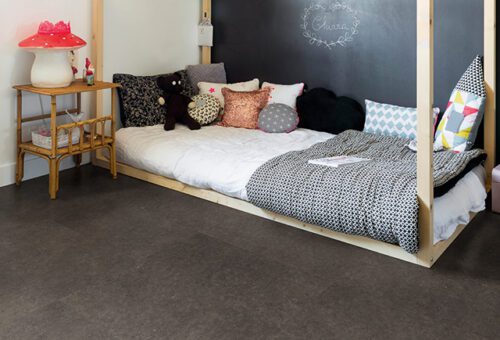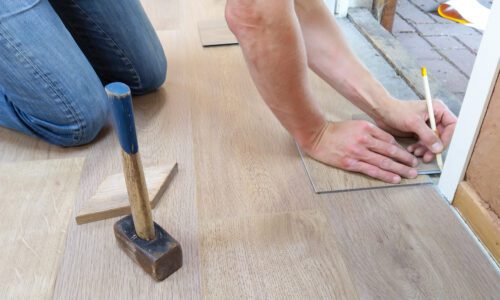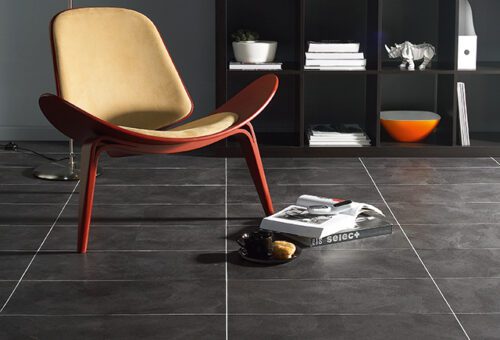How to Install LVT Flooring in STEPS
Add a touch of elegance to your flooring, with our selection of textures and attractive designs. Luxury Vinyl Tiles (LVT) give you the realistic look of a wooden or stone floor, whilst being waterproof and resistant to damage. This makes them the ideal flooring solution for light commercial settings and home interiors, including bathroom and kitchen flooring.
You can browse our Luxury Vinyl Tiles to find what suits you, or get in touch with our team. We’ll be more than happy to help!
In this blog we’ll guide you through how to install Luxury Vinyl Tiles in steps, offering you tips on different subfloors and all the right tools you’ll need to lay LVT vinyl flooring.

Choose the right tools to lay LVT flooring
Whether you intend to install your luxury vinyl tiles over a concrete or wood subfloor, you need to make sure you have the right tools for the job. While the specifics might vary from job to job, these are some of the essentials you’ll need for any luxury vinyl tile project.
Tape measure: if you want to install your LVT flooring with a perfect fit, you’ll need to take accurate measurements of the room and your materials.
Utility knife: used for cutting through luxury vinyl tiles to ensure an accurate fit.
Pencil: used for marking the floor and tiles alike.
¼ inch spacers: these are laid along the perimeter wall and allow your vinyl tiles space to expand and contract with changes in temperature.
Putty knife and crowbar: used for removing skirting boards prior to the installation process.
Carpenter’s level: used to confirm that the underfloor (whether concrete or wood flooring) is level before installation and that your vinyl tiles are level following installation.
LVT are available for immediate purchase from our online store. Alternatively, call Afloor today for free advice and guidance on your next flooring project.
Key precautions to take when you install LVT flooring
The key to a successful LVT installation is to ensure you are properly prepared. This involves a few simple precautions you can take to avoid some common mistakes.
Test for moisture
A few days before you start, lay down one tile and seal it along each edge with a strip of duct tape. Leave it in the room for three days, and then remove it. If you can lift the tape easily, your underfloor might hold too much moisture to take a full LVT installation.
Acclimatise your vinyl flooring
LVT expand and contract depending on the temperature of the room. Be sure to move your LVTs to the room 48 hours before you plan to install them. This gives it a chance to acclimate to its surroundings.
Prepare your subfloor
A new luxury vinyl tiled floor is only as good as the subfloor beneath it. Whether you’re laying over concrete, wood, or ceramics, you must ensure the subfloor is level, dry, and dust-free.
Make sure you have enough materials
Few things are more frustrating than having to stop midway through an installation because you’ve run out of tiles or adhesive. Careful measurements and accurate calculations can help ensure you have the right amount of materials on hand to complete the project.

How to install LVT flooring on concrete: A step-by-step guide
AFloor provides only the highest quality LVT. With them, you can create an incredible new floor – one that looks and feels amazing. Follow our step-by-step guide to produce unbelievable results in your home or place of business.
1. PRY OUT THE SKIRTING BOARDS
To get a wall-to-wall effect when fitting LVT vinyl flooring, your tiles will need to be installed beneath the skirting board, which means the boards will have to be removed prior to installation. Using a utility knife, cut away any paint that might be covering the gap between the skirting board and the wall.
Insert a putty knife into the gap to cut away any adhesive. If your skirting boards are nailed in place, use a crowbar to loosen the nails. If you plan to reuse your existing skirting boards, take care when removing them so that they aren’t damaged.
2. CHECK THE FLOOR FOR CRACKS
Cracks in your concrete subfloor can compromise its stability, making it difficult to get the even finish you need. Use a floor levelling compound to fill in any cracks or divots, smoothing it out with a trowel or putty knife, depending on the size.
3. ENSURE THE SUBFLOOR IS LEVEL
With any cracks filled, you need to ensure the subfloor is level. Take a carpenter’s level (or spirit level) and work your way across the subfloor taking measurements. If the subfloor rises or dips more than 5mm over a 3m distance, you will need to even it out.
4. EVEN OUT THE SUBFLOOR
If you discover a rise in your concrete subfloor, the easiest way to remedy it is with a belt sander. Run this useful tool over the area in question, checking with a level at regular intervals until it is even. Don’t be too forceful with the sander – it’s better to take your time and get it right, rather than sand too hard and have to fill it back in again.
If you’ve discovered a dip in the subfloor, you need to raise it to the level of the rest of the floor. The best way to do this is with a levelling compound. This requires you to prime the concrete subfloor before applying the compound as a liquid. This automatically levels out to an even finish and must be allowed to dry before fitting your vinyl floor tiles.
5. CALCULATE THE NUMBER OF VINYL TILES YOU NEED TO FIT THE ROOM
Nobody wants their vinyl tiles to go to waste. Likewise, nobody wants to have to stop partway through the job to buy more. The easiest way to know you have the right amount is to measure the area of the room and work out how many tiles will fill it.
For a standard rectangular room, this is easy. Most vinyl tiles are square, so you don’t need to worry about long or short edges. Measure along one wall and divide it by the length of a tile. Always round up to a full number of tiles. Do the same for the adjoining wall. Take those two figures and multiply them, and that will give you the total number of tiles needed. Always add on an extra tile or two to allow for mistakes or extra tricky areas such as alcoves etc.
6. LAY THE FIRST ROW OF TILES
Like with a jigsaw, start laying your vinyl floor at one of the corners and work your way out. Use your 1/4-inch spacers to leave an expansion gap between the wall and your first row of tiles. Make sure you do this on both connecting edges of the corner tile.
Apply adhesive to the underside of the tile as per instructions. Some adhesives require you to coat the concrete floor as well as the back of the tile, while others only require one or the other. Make sure the room is well-ventilated and that you wear face and eye protection.
Hold the tile in place while it bonds. Again, your manufacturer’s instructions will advise you on the right length of time. Once the first corner tile is in place, you can repeat the process to lay the second tile. Be sure to keep each subsequent tile in line with the previous one, as well as the 1/4-inch expansion gap along the wall.
When you reach the end of the wall, you may need to cut the tile to get the ideal fit. Use a steel ruler and a pencil to measure up accurately, before cutting the tile to size with a utility knife.
7. INSTALL SUBSEQUENT ROWS OF TILES
The next row of tiles should be easy. Simply follow the line of tiles that you have already fitted (as well as the gap between the tiles and the wall) and you should have no problem. Repeat the process as you go, being careful to keep each row neat and in line with the one preceding it.
8. INSTALLING THE LAST ROW OF TILES
The last row of tiles may require you to trim them to fit the room properly. You can do this in the same way that you have with the other walls, measuring the right fit for each tile and trimming it to size with your utility knife. Once the final row has been fitted and allowed to set, you can reinstall your skirting boards.
How to install vinyl tiles on wood subfloors
Our step-by-step guide largely concerns itself with concrete subfloors, as these are the most common type of subfloor for laying LVT. Fitting vinyl tiles to wood subfloors follows much the same process but requires a little extra preparation.
With a wooden subfloor, any rises or dips are most likely due to a warped floorboard. Remove the boards carefully and confirm if they have a bend or warp in the wood. If so, it will need to be replaced with a new floorboard before laying your vinyl tiles.
It’s also important that there are no splinters on your wooden floor prior to installing a vinyl floor. These can interfere with the adhesive, making it more difficult to stick. Speaking of adhesives, be sure to choose one that is formulated to stick vinyl to wood.

How to protect and maintain vinyl flooring
LVT is made from durable and hard-wearing materials. If you install them properly and treat them with care, there is no reason that they shouldn’t last you for decades. Follow these simple tips to improve the longevity of your flooring.
DO read the manufacturer’s instructions that come with your LVTs. These will advise you of any particular chemicals or treatments that you should avoid when cleaning your new floor.
DON’T use abrasive cleaning tools to clean your LVTs. These include scouring pads, scrubbing brushes, and even the beater bar on your vacuum cleaner. Any of these items can cause scratch damage to your floor.
DO use non-staining doormats. It’s always advisable to have a doormat wherever people come in from the outside. Wet shoes and LVT floors can result in slipping accidents, not to mention marking your floor. When choosing a doormat, choose one without a rubber, cocoa, or latex backing, as these can cause discolouration.
DON’T drag heavy furniture across an LVT floor. Instead, you should fit the legs of your furniture with coasters to make the movement easier and prevent damaging your new tiles.
DO clean up any spills as soon as possible. While vinyl itself is waterproof, spillages can stain the surface and are also a slip hazard for anyone entering the room.
Recommended vinyl floor products
As your local vinyl flooring experts, we know the best products for your luxury vinyl tile flooring installation. These are some of our most popular products, available for immediate purchase from our online store.
Luxury Vinyl Tiles
When it comes to quality vinyl tiles, nobody does it better than Polyflor. Their luxury tiles are both attractive and durable, meaning you can rely on them for years of regular use. Camaro is a collection of LVT, replicating the natural beauty of wood, designed for use in all residential and light commercial interiors.
Adhesives and Screed
Preparing your subfloor with self-levelling compounds and the right adhesive for the job are just two ways to ensure the longevity of your new LVT flooring.
All of the above products, and more, are available from our online store. If you need professional advice on which products will work for you, call Afloor today. Visit our guide if you want to learn how to clean LVT flooring or for more tips on repairs and keeping your LVT flooring fresher for longer, visit our restoration guide for LVT flooring.
